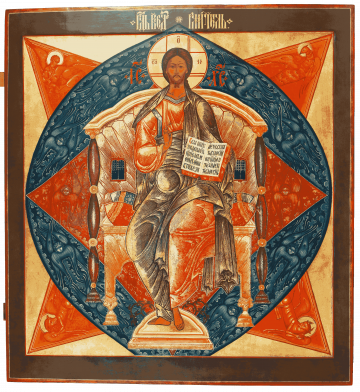The Saviour in Power
(Russia; nineteenth century)
Russia; nineteenth century; 107 x 97 cm
Iconography
The icon of Christ in glory is called Спас в силах - Saviour in the midst of the heavenly powers in Church Slavonic. This icon, which is fundamentally very close to the “Christ on the Throne” icon, depicts Christ sitting on a throne with a blessing right hand on the background of three geometric shapes: a rhombus, a circle and a quadrangle, which form the boundaries for the figure of Christ dressed in a red-brown robe. Its lines are depicted in gold colour with hatching (assistos).
The red rhombus is a symbol of Christ's divine glory. The circle, a foreshadow of heaven, is in a dark blue shade. Seraphs with six wings are depicted in it. Their depiction is based on the vision of the prophet Isaiah: “I saw the Lord sitting on a throne, high and lifted up, and the train of His robe filled the temple. Above it stood seraphim; each one had six wings: with two he covered his face, with two he covered his feet, and with two he flew. And one cried to another and said: “Holy, holy, holy is the Lord of hosts; The whole earth is full of His glory!” (Isaiah 6:1-3) The quadrangle, as the largest formation, which is the symbol of the earth, has the symbols of the four evangelists inscribed in the corners: at the top left – a winged man - the symbol of the apostle and the evangelist Matthew; at the top right – an eagle – the symbol of the apostle and the evangelist John; at the bottom left – a winged lion – the symbol of the evangelist Mark and finally at the bottom right – a winged bull – the symbol of the evangelist Luke. “And in the midst of the throne, and around the throne, were four living creatures full of eyes in front and in back. The first living creature was like a lion, the second living creature like a calf, the third living creature had a face like a man, and the fourth living creature was like a flying eagle.” (Revelation 4:6-7)
The iconography “Saviour in Power” appears in Byzantium in the twelfth - thirteenth centuries. It did not spread to Russia until the end of the fourteenth century. The theme of the icon is the eschatological depiction of parousia (παρουσία) – the second glorious coming of Christ to earth when He will come to judge the world.
Description of the icon
The icon depicts Christ dressed in a red-brown robe, the lines of which are shown in gold. Beneath the footstool at the Saviour's feet are three pairs of outlines, as if circles with wings, symbolically representing the Thrones, the angels of the first degree of the heavenly hierarchy according to Pseudo-Dionysius the Areopagite. They are depicted as fiery wheels with wings all around. The Saviour is traditionally giving blessings with his right hand and in his left hand on his left leg he is holding an open Gospel with the text: “All things have been delivered to Me by My Father, and no one knows the Son except the Father. Nor does anyone know the Father except the Son.” (Matthew 11:27) The name of the icon Господъ Всєдєржитєлъ – Omni-ruler is at the top of the icon above the figure of Christ. There is a cross nimbus with the Greek letters Ѡ Ѻ N around his head. There is the monogram of Jesus Christ IC XC on the sides of the nimbus.


